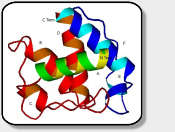Distance Learning: Techniques in Structural Molecular Biology (TSMB)
Postgraduate Certificate
| TSMB Syllabus | ||||||||||||
| Section 8: Protein NMR |
Nuclear magnetic resonance (NMR) is the second most important technique for determining the three- dimensional structure of macromolecules. This section provides an introduction to NMR with an emphasis on those techniques that are particularly important in structural biology.
|
Objectives To provide background material for students unfamiliar with NMR spectroscopy and revision material for those that are. To show how 1H NMR is a valuable analytical technique in protein studies. To show how dynamic aspects of NMR can be used to determine the structure and dynamics of proteins in solution. At the end of this section, students should
|
